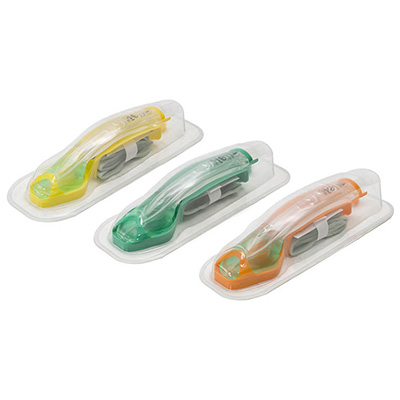Supraglottic airways (SGAs) are devices used to secure the airway in an adult patient who is unable to maintain an open airway. SGAs are also referred to as extraglottic or periglottic devices. These devices are often used in patients with difficult airways and those who have failed initial attempts at tracheal intubation.
Supraglottic airways are devices used to provide an airway during emergencies. They can be inserted into the mouth and throat, in contrast to endotracheal tubes (ETTs) that go down into the patient’s upper airway. Supraglottic airways may be inserted to secure an adequate airway for a patient who cannot breathe or has an inadequate cough reflex.
Supraglottic airway devices are key adjuncts in difficult airway management. They allow the rescuer to adopt a “go slow, go safe” approach whilst maintaining ongoing attempts at tracheal intubation. This is particularly useful when there is an increased risk of hypoxaemia or hypercapnia associated with intubation attempts and when the patient requires continuous oxygen therapy or positive pressure ventilation during the process.
A supraglottic device consists of a flexible tube with an inflatable cuff that fits into the oral cavity. It is placed between the base of the tongue and the epiglottis to prevent airway obstruction during breathing.
Supraglottic devices are more likely than other types of airways (e.g., nasopharyngeal) to maintain patency in patients with difficult airways because they provide direct visualization of the larynx and pharynx during insertion and use.
How Do SGAs Compare With Oral Endotracheal Intubation (ETI)?
Supraglottic airways (SGAs) are easier to place than oral endotracheal intubation (ETI), more effective at preventing oxygen desaturation, and are generally safer.
The current gold standard for airway management is the use of an endotracheal tube. The insertion technique for an endotracheal tube requires passing the tube into the trachea and securing it with tape or sutures. The process requires visualization of the patient’s airway with a laryngoscope for proper airway placement. This procedure, done under general anesthesia, may be challenging in some patients and is not always successful in others. The success rate for placing an endotracheal tube in clinical practice ranges from 70% to 95%. Risks include accidental placement of the tracheal tube in the patient’s esophagus.
The alternative to ETI is supraglottic airways (SGAs). SGAs are designed to be inserted into a patient’s mouth. Once inserted, they form a seal around the entrance of the larynx.
Types of SGA Devices
Laryngeal Mask Airway (LMA)
First introduced in the 1980s, LMAs (such as the Air-Q) were used in operating rooms and prehospital settings. In emergency medicine, LMAs were a temporary solution to incidents where a patient could not be intubated. In contrast to bag valve masks, LMAs decrease the risk of aspiration of gastric contents. Unlike bag valve masks, which utilize a facemask, they do not have the potential to send air down the esophageal passage.
Combitube
A combitube is meant to be positioned outside the glottis and consists of a double-lumen tube with two cuffs and two syringes that have been pre-primed to the correct inflation volume. They come in two sizes but are not suited for pediatric patients.
I-Gel Supraglottic Airway
The I-Gel Supraglottic Airway, manufactured by Intersurgical, is a second-generation advanced airway widely used in anesthesia and resuscitation. The device creates an anatomical seal of the pharyngeal, laryngeal, and perilaryngeal areas while decreasing compression trauma to the patient. The soft, non-inflatable cuff eliminates the need for inflation of the cuff following airway insertion. Since it can be administered with great speed, the I-Gel O2 Resus Pack is ideal for emergency medical services (EMS) personnel or intensive care scenarios.
When Should I Use an SGA Instead of ETI?
-
- If you’re dealing with a difficult airway, where intubation is difficult or impossible, then an SGA may be the best choice.
- If the patient has failed at least three intubation attempts and they’re still not breathing, then an SGA may be preferable over ETI because of its ease of use.
Effectiveness/Safety Between Different Generations of SGAs?
It is important to note that there are some differences between generations of SGAs, but the majority of these differences are related to design. For example, the earliest generations of SGAs were made from polyvinyl chloride (PVC). Later generations use silicone as a flexible material that makes placement easier and more comfortable for patients.
Do SGAs Work in All Patients?
As with all airway management techniques, SGA use does have contraindications. The extraglottic device may be unsuitable for patients with a large tongue, a large mandible or a very small mouth. Additionally, SGAs are not suitable for patients who have an airway obstruction (such as from blood or vomitus), or an injury of the cervical spine. If a patient is undergoing chest compressions for cardiac arrest, the procedure will have to be interrupted for SGA insertion.
Supraglottic Airways: The Best Alternative to ETI
Supraglottic airways are a safe, effective and easy-to-use adjunct in the management of difficult airways. They provide an alternative to direct laryngoscopy where tracheal intubation is not possible or likely to be unsuccessful. When used as alternatives to nasal intubation, supraglottic airway devices should be considered first due to their lower risk of complications from loss of oxygen supply, regurgitation or aspiration compared with blind nasotracheal intubation attempts.
When you’re looking for the best selection of airway management tools, shop with the experts at Penn Care.



